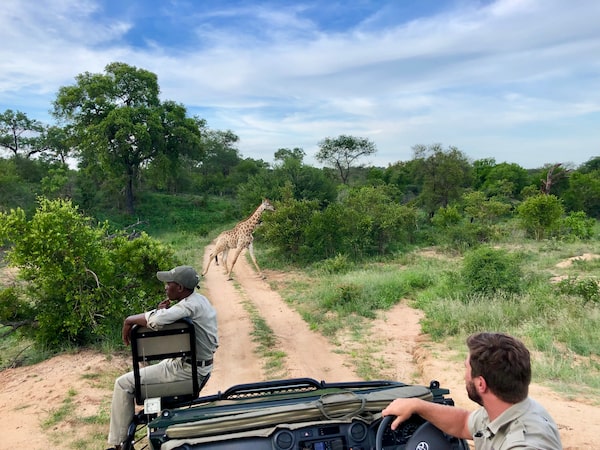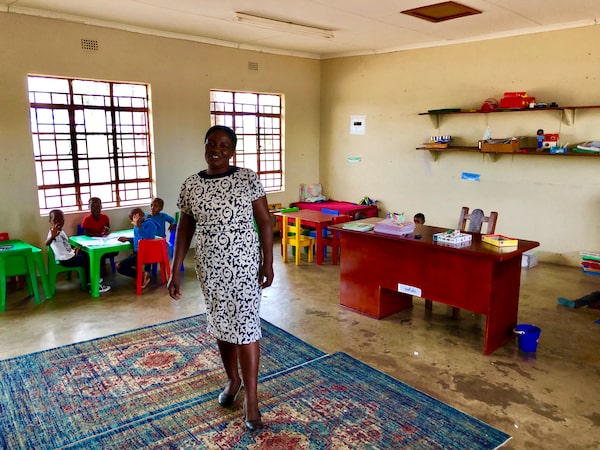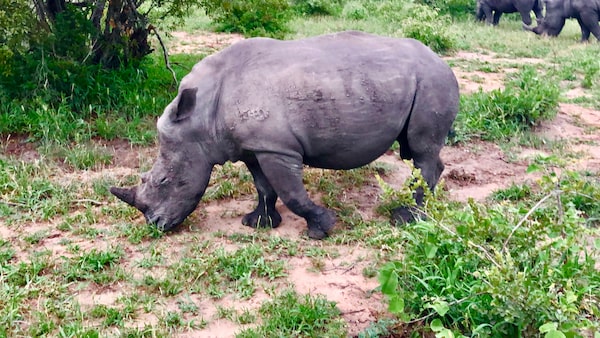
Guide Jonty Tatz drives a 4x4 while tracker Richard Sithole helps locate creatures in South Africa's Kruger National Park.Tim Johnson
For a guy with an expert eye, tracking wildlife in the African bush doesn’t take long – especially when the animals don’t wander too far from riverbeds and dirt roads, supple surfaces where they make a clear and lasting impression. But searching for tracks can quickly become more difficult once the beasts stray from the beaten path and wander deeper into the bush. Then the clue might be a single bent blade of grass, or perhaps a broken twig. More often it’s just a feeling, a sort of stroke of intuition, that leads that tracker to some of the continent’s biggest cats and other members of the Big Five (lion, leopard, elephant, rhinoceros, Cape buffalo).
On this afternoon, it takes a little more than 10 minutes for Richard Khoza, who has been working as a tracker for 36 years. With guide Bernard Stiglingh at the wheel, we take the safari 4×4 vehicle for a scout, dropping Khoza, stoic and focused, near a set of fresh tracks along a dry riverbed. We leave him – eyes down, steps straight and methodical – to trace the tracks into the thick underbrush that lines each side. Minutes later, the radio crackles to life – Khoza has spotted two juvenile leopards lazing up in a tree. We roll up to find him standing nonchalantly beside a small pond, inspecting a large feather, seemingly unworried about the dangerous animals nearby. Later, I ask him what he fears after all these years in the wild. “Oh, nothing, now,” he says, thinking carefully. He then quickly corrects himself. “Well, I fear God, but nothing else.”
I’m in the Ngala Private Game Reserve, a private preserve that directly adjoins South Africa’s famed Kruger National Park, which sprawls across almost 20,000 square kilometres (an area roughly the size of Israel). While most such safaris require little more derring-do than simply riding around in a cushy vehicle under the sun, I’m here to do something unusual – that is, get out and walk. A growing number of younger, more active travellers are looking to go beyond the confines of the 4×4 vehicle and to engage with the surrounding environment (and culture) on a deeper level. I will visit villages, get closer to nature, ride at night, and, perhaps most importantly, learn a few lessons about how to track animals myself.

While most safaris are confined to a vehicle, Sithole and Tatz later take visitors on a walk that allows them to pick up on small sounds and details they might miss.Tim Johnson
Together with a small group, my trip begins further south at the new Tengile River Lodge, located inside Sabi Sand, another private game reserve connected to Kruger. While most camps this deep into the bush are often tented, Tengile has nine spacious, air-conditioned villas lining the Sand River, each with its own private patio and lap pool. And while on most safaris a guide will also double as a driver and a tracker, here the responsibilities are split up between two men – guide Jonty Tatz will drive the 4×4 vehicle and Richard Sithole will have the sole job of tracking game. We start slow, going out on morning and evening “game drives,” the most traditional safari activity – basically rolling out in the vehicle and seeing what’s out there.
And we see plenty, getting up close to a massive herd of elephants, perhaps 100 in all, as well as rhinoceros, a massive python and a whole den of hyenas. But we do more, too. While most safaris end after sundowner drinks – gin-and-tonics and a nice view of the sunset – we continue on. “Let’s see what the night has for us,” Tatz says with a smile as we seek out wildlife hidden by a darkness so complete it’s broken only by Sithole’s insistent, slow swing of a powerful spotlight. The beam reveals a whole, additional set of nocturnal animals, including owls, spring hares and serval. Soon we find a large female leopard tucked away near a tree, under the stars. Sithole uses his beam to lead us through the bush to see her.

Sithole and Tatz set up a bar for drinks at sundown.Tim Johnson
The next day, Tatz takes us for a walk. While we’re not actually tracking any animals, anytime you leave the vehicle there’s an element of risk, and so our guide carries a gun. “Stay behind me – and the rifle – at all times,” says the normally jovial Tatz as we venture along a path. He explains that nature walks such as this one provide an experience you would miss in the vehicle – sounds and tiny details lost as you whiz by. He points out a destroyed tree (“an elephant walked right over it to scratch his belly”) and a termite mound (“this is just the tip of the iceberg – just think, there are millions of termites just below our feet”) and, from a bit of a distance, a huge male nyala (“his horns are thick – with one strike, he can kill a leopard”). We dissect some dung to see what the animals have been eating, and see some butterflies that, Tatz explains, mimic monarchs. Right at the end, we spook a herd of antelope, who turn tail and run.
From Tengile, we drive a few hours north to Ngala, stopping along the way to tour a couple of villages just outside Kruger. Increasingly, safari travellers are seeking to engage with the population that surrounds the parks, and companies such as andBeyond (which owns Tengile and Ngala) are supporting their visits and, in turn, the communities. We visit the Happy Home Preschool, tidy and organized, as well as Madilika Craft Centre, which sells locally produced handmade items and offers business, and art, mentorship programs.

A teacher at Happy Home Preschool, outside Kruger National Park.Tim Johnson
Arriving at Ngala, we take some game drives, at one point seeing a white lion cub – one of only two known in the world in the wild – and we follow Khoza to all sorts of other animal sightings.
One morning, I awake early for a personal tracking lesson with Khoza. Unlike my earlier amble, which was in an area without known predators, something known as a “nature walk,” here Khoza and Stiglingh – both specially trained to take guests into wilder areas – lead me to a place called Buffalo Plains. True to its name, when we stop and climb out of the 4×4 vehicle, we spot a lone male Cape buffalo nearby. Stiglingh explains that this particular bull is familiar to them and is known to charge and thus is too dangerous to approach.
We take the vehicle to our next location, and after Stiglingh has loaded three rounds into his rifle for safety (he says he’s never fired the gun), we wander out onto the plains. Khoza explains that tracking is a multisensory skill – hearing, scent and sight mainly, but also that sixth sense. “You have to think like the animal,” he says. “From growing up in the bush, you just know.”

Tim Johnson

Visitors can encounter some of Africa's most famous animals, such as elephants and rhinos, during game drives in Kruger.Tim Johnson/The Globe and Mail
We find plenty of tracks. Passing the jawbone of an unfortunate wildebeest picked clean by predators and scavengers, we reach a “pan.” At the mostly dry small pond, Khoza points out some hyena tracks – “four nails, with back pads” – but they’re not fresh. “If the tracks of nocturnal animals cross them, it’s a dead giveaway that they’re at least a day old,” Stiglingh says. At another pan, still listening for alarm sounds from birds and antelope in the area – strange squawks and shrieks that provide a sure signal of a predator nearby – we find tracks from leopard, mongoose and wildebeest, but they’re not fresh, either.
On the way back to the vehicle, Khoza finds a small shard from a pot maybe a century old (he’s also stumbled across stone-age tools in the area), and points out a series of medicinal plants: One is a sort of natural Viagra used by rhinos and impalas during mating season; another is taken for an upset stomach, an organic cure that Khoza himself uses. We don’t track down any cats, but as we climb back onto the 4×4 vehicle and bump back down the trail to our breakfast waiting at the lodge, I feel like I’ve had a deeper, fuller safari experience – and that, just maybe, given a few more lessons with Khoza and some more time out on the savannah, next time I could be the guy to spot the leopard.
When you go
At andBeyond’s newly opened Tengile River Lodge, the bedrooms and bathrooms of each suite open out to the forest, with raised decks from that guests can often view nearby wildlife, including elephants, which often wander up from the Sand River. The structures were built with attention to sustainability (for example, wastewater is recycled and the power is solar), and with local materials. Ngala Safari Lodge was completely renovated in 2016, an infinity pool added, its thatched villas enlarged and the watering hole – which attracts a wide variety of local wildlife – deepened. Rates begin at $850 a person a night, including three meals a day, beverages, laundry and all safari activities. andbeyond.com
Almost every safari adventure to Sabi Sand, Ngala and Kruger will pass through Johannesburg. There, stay at The Residence, an exclusive boutique property tucked into a leafy suburb – the hotel has an old-world feel, with rambling lounges and library, plus suites with chandeliers and (some) with private hot tubs. Rates start at $300 a night. theresidenceportfolio.co.za/the-residence-boutique-hotel.html
Providing the only direct flight from Canada to sub-Saharan Africa, Ethiopian Airlines is a Star Alliance partner and flies to South Africa with just one connection in Addis Ababa. Their Cloud Nine business class cabin provides premium wine and food (including traditional Ethiopian food), as well as lie-flat beds, an essential key to comfort on the long journey. Ethiopianairlines.ca
The writer travelled as a guest of andBeyond. It did not review or approve this article.
Live your best. We have a daily Life & Arts newsletter, providing you with our latest stories on health, travel, food and culture. Sign up today.